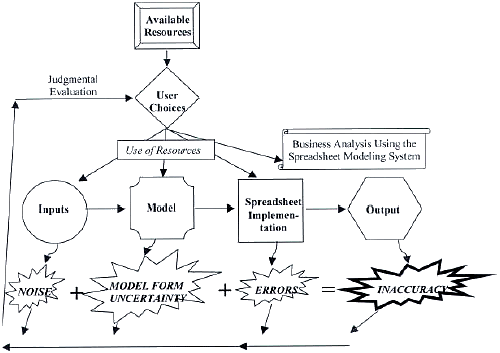Authors
Thomas A. Grossman
Abstract
Accuracy in spreadsheet modelling systems can be reduced due to difficulties with the inputs, the model itself, or the spreadsheet implementation of the model.
When the "true" outputs from the system are unknowable, accuracy is evaluated subjectively. Less than perfect accuracy can be acceptable depending on the purpose of the model, problems with inputs, or resource constraints.
Users build modelling systems iteratively, and choose to allocate limited resources to the inputs, the model, the spreadsheet implementation, and to employing the system for business analysis.
When making these choices, users can suffer from expectation bias and diagnosis bias. Existing research results tend to focus on errors in the spreadsheet implementation. Because industry has tolerance for system inaccuracy, errors in spreadsheet implementations may not be a serious concern. Spreadsheet productivity may be of more interest.
Sample

This figure describes the process of creating and using a spreadsheet modelling system.
The user obtains inputs, creates a model, and implements it in a spreadsheet. Because model development is usually iterative, the user goes through several cycles of examining system components (inputs, model and spreadsheet implementation).
He uses judgmental evaluation of the outputs and each of the components to guide allocation of resources at each iteration.
The level of inaccuracy from input noise, model form uncertainty, and spreadsheet implementation error are affected by the resources devoted respectively to model inputs, the model itself, and engineering the spreadsheet implementation.
Publication
2003, EuSpRIG
